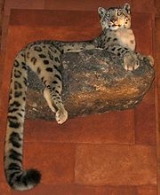
Taxidermy
Overview
Taxidermy is the act of mounting or reproducing dead animal
s for display (e.g. as hunting trophies
) or for other sources of study. Taxidermy can be done on all vertebrate species of animals, including mammal
s, bird
s, fish
, reptile
s, and amphibian
s. The methods taxidermists practice have been improved over the last century, heightening taxidermic quality and lowering toxicity. The animal is first skinned in a process similar to removing the skin from a chicken prior to cooking.
Animal
Animals are a major group of multicellular, eukaryotic organisms of the kingdom Animalia or Metazoa. Their body plan eventually becomes fixed as they develop, although some undergo a process of metamorphosis later on in their life. Most animals are motile, meaning they can move spontaneously and...
s for display (e.g. as hunting trophies
Trophy hunting
Trophy hunting is the selective hunting of wild game animals. Although parts of the slain animal may be kept as a hunting trophy or memorial , the carcass itself is sometimes used as food....
) or for other sources of study. Taxidermy can be done on all vertebrate species of animals, including mammal
Mammal
Mammals are members of a class of air-breathing vertebrate animals characterised by the possession of endothermy, hair, three middle ear bones, and mammary glands functional in mothers with young...
s, bird
Bird
Birds are feathered, winged, bipedal, endothermic , egg-laying, vertebrate animals. Around 10,000 living species and 188 families makes them the most speciose class of tetrapod vertebrates. They inhabit ecosystems across the globe, from the Arctic to the Antarctic. Extant birds range in size from...
s, fish
Fish
Fish are a paraphyletic group of organisms that consist of all gill-bearing aquatic vertebrate animals that lack limbs with digits. Included in this definition are the living hagfish, lampreys, and cartilaginous and bony fish, as well as various extinct related groups...
, reptile
Reptile
Reptiles are members of a class of air-breathing, ectothermic vertebrates which are characterized by laying shelled eggs , and having skin covered in scales and/or scutes. They are tetrapods, either having four limbs or being descended from four-limbed ancestors...
s, and amphibian
Amphibian
Amphibians , are a class of vertebrate animals including animals such as toads, frogs, caecilians, and salamanders. They are characterized as non-amniote ectothermic tetrapods...
s. The methods taxidermists practice have been improved over the last century, heightening taxidermic quality and lowering toxicity. The animal is first skinned in a process similar to removing the skin from a chicken prior to cooking.
Unanswered Questions
Discussions

